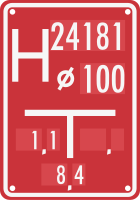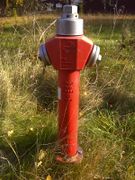Pl:Key:fire hydrant:*
| Opis |
|---|
| Określa właściwości hydrantu. |
| Grupa: Ratownictwo |
| Używane na tych elementach |
| Wymagane znaczniki |
| Status: de facto |
| taginfo: fire_hydrant:* |
fire hydrant:*=* – stosowany do określenia szczegółów hydrantu przeciwpożarowego.
fire_hydrant:type=*fire_hydrant:diameter=*fire_hydrant:position=*fire_hydrant:pressure=*fire_hydrant:water_source=*fire_hydrant:coupling_type=*fire_hydrant:flow_capacity=*
Używane prefiksy
fire_hydrant:diameter

ref=24181) i średnicy przewodu 100mm (fire_hydrant:diameter=100 mm) znajdującego się 1,1 metra na lewo w odległości 8,4 metra od tego znaku.fire_hydrant:diameter=* – średnica rury biegnącej pod ziemią do której podłączony jest hydrant, podana w milimetrach (mm), np: 80.
Wartość powinna być podana na tablicy orientacyjnej dla hydrantu, za symbolem ø.
Nie należy mylić tego tagu ze średnicą przyłączy – couplings:diameters=*.
fire_hydrant:position
fire_hydrant:position=* – opisuje położenie hydrantu:
| tag | opis | zdjęcie | Taginfo |
|---|---|---|---|
fire_hydrant:position=green
|
na trawniku, na terenie zielonym |  |
|
fire_hydrant:position=sidewalk
|
na chodniku |  |
|
fire_hydrant:position=lane
|
na pasie drogi |  |
|
fire_hydrant:position=parking_lot
|
na parkingu |  |
|
Zobacz wszystkie wartości na TagInfo:
| |||
fire_hydrant:pressure
fire_hydrant:pressure=* – określa ciśnienie robocze w barach:
8– 8 barów;2– 2 bary; itd. Jeżeli mapujemy przewód ssący (brak ciśnienia), należy wpisać:
suction– przewód ssący
Standardowo ciśnienie robocze w polskich sieciach to 8 barów.
fire_hydrant:type
fire_hydrant:type=* – opisuje typ hydrantu:
| tag | opis | zdjęcie | Taginfo |
|---|---|---|---|
fire_hydrant:type=pillar
|
Hydrant nadziemny – zwykły słupek.
Dokładny rodzaj słupka można uszczegółowić w tagu |
 |
|
fire_hydrant:type=suction_point
|
Rura ssąca, podłączenie do jeziora / rzeki (nazwa zwyczajowa "Suchy Hydrant").
Miejsce, gdzie można nabrać wody ze zbiornika, ale nie ma specjalnych udogodnień (rury) oznaczamy |
 |
|
fire_hydrant:type=underground
|
Hydrant podziemny. | ||
fire_hydrant:type=wall
|
Hydrant naścienny. |  |
|
Zobacz wszystkie wartości na TagInfo:
| |||
Dawne tagi
fire_hydrant:water_source
fire_hydrant:water_source=* – źródło wody w hydrancie. Zamiast niego należy używać tagu water_source=*.
fire_hydrant:coupling_type
fire_hydrant:coupling_type=* – rodzaj przyłączy do których można podłączyć sprzęt. Zamiast niego należy używać tagu couplings:type=*.
fire_hydrant:count
fire_hydrant:count=* – liczba hydrantów znajdująca się faktycznie w miejscu węzła ![]() . Zamiast niego należy oznaczać każdy hydrant osobno – zobacz: Jeden obiekt, jeden element OSM.
. Zamiast niego należy oznaczać każdy hydrant osobno – zobacz: Jeden obiekt, jeden element OSM.
Liczbę przyłączy należy oznaczać w tagu couplings=*.

